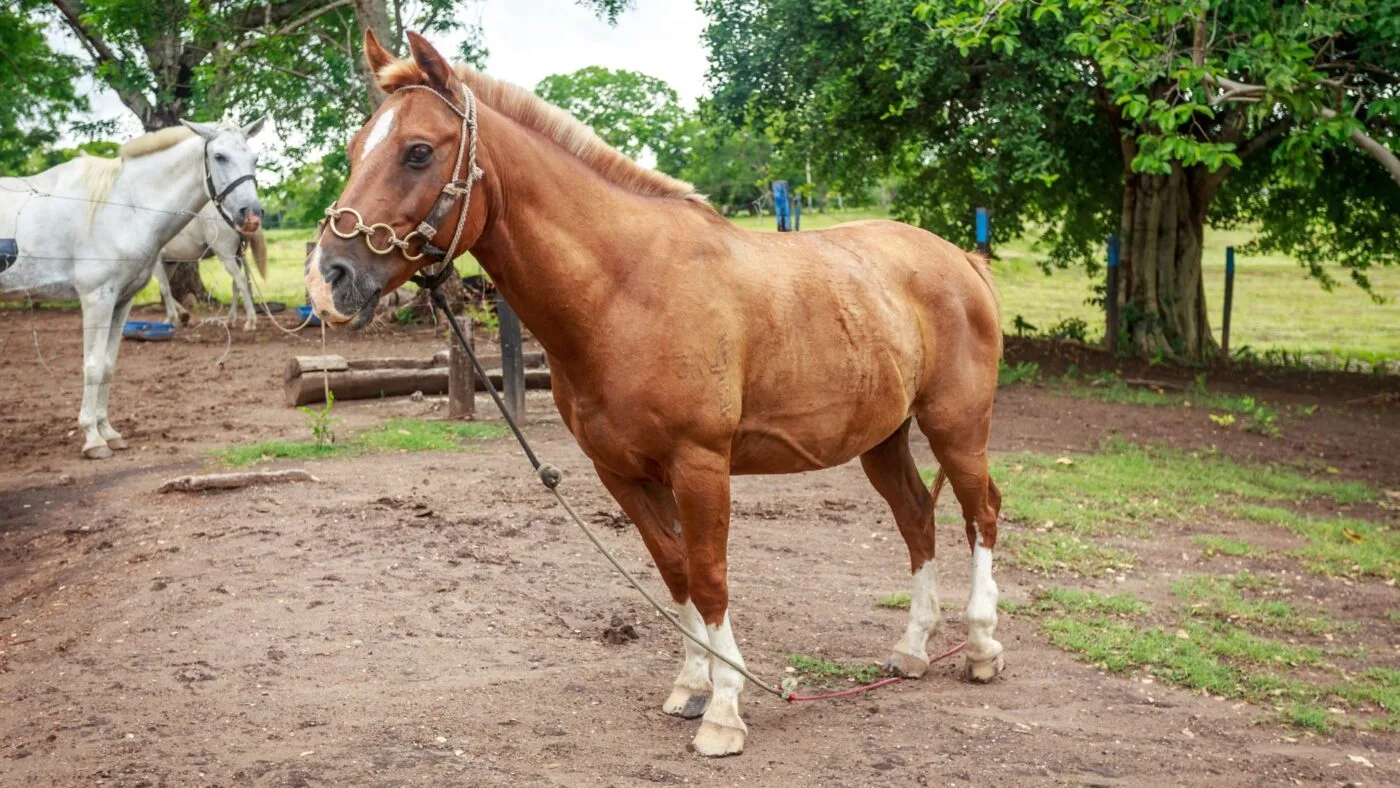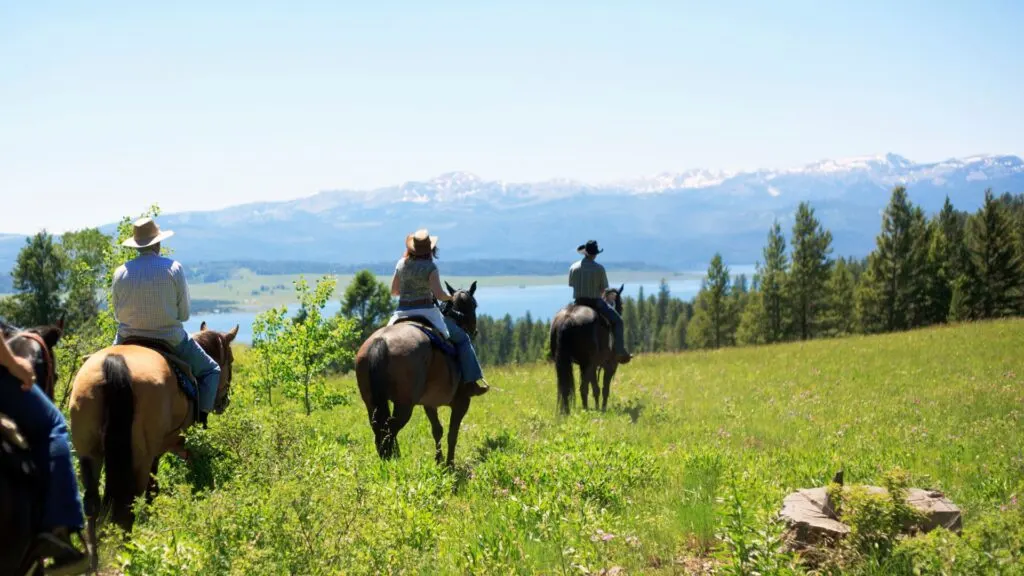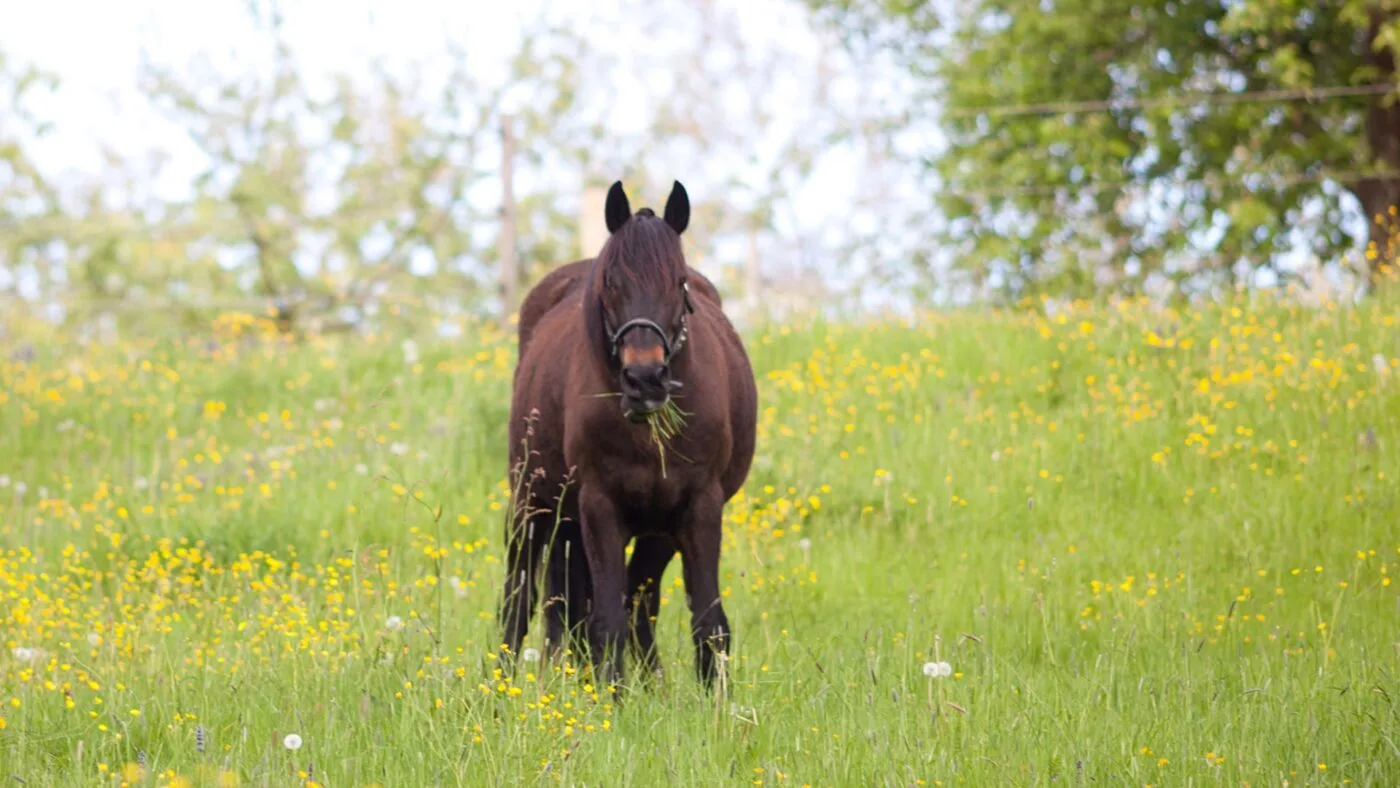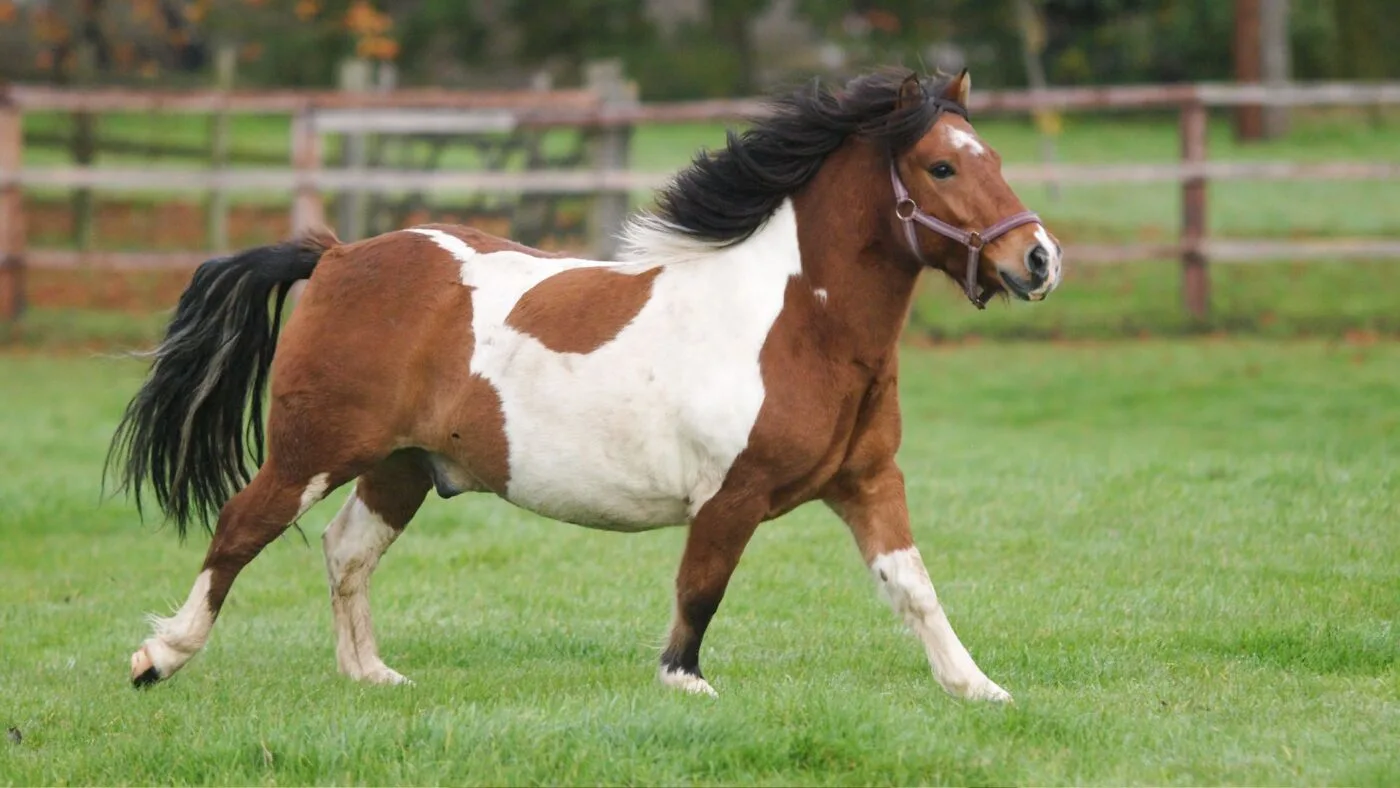Last updated: March 25, 2024
Any links on this page that lead to products on Amazon are affiliate links and I earn a commission if you make a purchase. Thanks in advance – I really appreciate it!
Managing an overweight horse goes beyond mere numbers on a scale; it’s a critical aspect of their overall health and quality of life. With my extensive background in horse care, I’ve seen how excess weight can affect everything from a horse’s performance to its overall well-being.
This isn’t just about keeping them looking good—it’s about ensuring they live a healthy, vibrant life. In this guide, we’re diving deep into equine weight management with insights from seasoned professionals and the latest studies. We’ll cover effective ways to evaluate and address weight issues, offering practical, research-based advice.

Understanding Equine Obesity
Equine obesity is more than just a weight issue; it’s a significant health concern affecting a horse’s overall well-being and lifespan. Let’s break down what constitutes equine obesity, its implications, and the factors contributing to this growing issue.
- Defining Equine Obesity:
- Obesity in horses is typically identified when their body weight is 20% or more above their ideal weight.
- It’s often assessed using the Henneke Body Condition Scoring system, where a score above 7 indicates obesity.
- Health Implications:
- Increased risk of laminitis, a painful and potentially debilitating hoof condition.
- Higher likelihood of developing metabolic disorders like Equine Metabolic Syndrome (EMS).
- Joint stress and increased risk of arthritis due to excess weight.
- Potential for decreased reproductive efficiency and other health complications.
- Prevalence and Causes:
- Studies suggest a rising trend in equine obesity, with lifestyle and management practices as key contributors.
- Common causes include:
- Overfeeding: Excessive calorie intake, especially from high-energy feeds and lush pastures.
- Lack of exercise: Sedentary lifestyle, especially in domesticated horses.
- Genetic predisposition: Certain breeds are more prone to weight gain.
- Misunderstanding of ideal body condition: Owners often perceive a heavier horse as healthy.
The insightful study “The Rise in Equine Obesity” by Alastair Hinch reveals that the increasing trend of horse obesity stems from a complex mix of factors. Key among these is owners’ overfeeding, a culture of rewarding heavier horses in show competitions, and prevalent negative peer pressure within the equestrian community.
Hinch’s study highlights the serious health risks linked to equine obesity, such as laminitis, diminished athletic capabilities, and various behavioral problems. This comprehensive analysis sheds light on the multifaceted nature of this growing issue in equine health. For more detailed insights, you can read the full article here.

Assessing Your Horse’s Weight
Determining if your horse is overweight requires more than just a visual assessment. As highlighted in a study from the UK, horse managers often struggle to visually identify overweight animals, which can delay weight management initiatives. The Henneke Body Condition Scoring (BCS) system offers a more objective approach.
The Henneke System
- What It Is: A systematic way to assess a horse’s body fat using a numerical scale.
- Areas to Evaluate: The system focuses on six key areas: the loin, ribs, tailhead, withers, neck, and shoulders.
- Scoring: Each area is assigned a score based on fat accumulation, with the total score indicating the horse’s overall body condition.

Hennecke Fat Deposits: Montanabw, CC BY-SA 3.0
Considerations for Accurate Scoring
- Avoid Misinterpretation: Large-bellied horses can be misleading. Stick to the specific reference points for each area.
- Breed and Age Factors: Adjust your scoring for different breeds and ages, as they can naturally carry more or less fat.
- Recognizing Obesity: A score above 7 typically indicates obesity, which is linked to health issues like laminitis.
Ideal Scores
- Healthy Range: A BCS of 4 to 6 is generally considered ideal for most horses.
- Overweight and Obesity: Scores of 7 to 9 indicate that the horse is overweight to obese, necessitating a weight management plan.
Implementing a Weight-Reduction Plan
- Start Slowly: Gradually introduce changes to the horse’s diet and exercise routine.
- Routine Monitoring: Regularly check the horse’s BCS to track progress and adjust the plan as needed.
Understanding and utilizing the Henneke system is crucial for maintaining your horse’s health and preventing obesity-related diseases. As the UK study mentions, better education and resources are needed to help horse managers and owners accurately assess and maintain appropriate body condition in horses.

Expert Insights on Equine Weight Management
In the quest to maintain the optimal weight of horses, insights from equine experts – nutritionists, veterinarians, and trainers – are invaluable. Their diverse perspectives shed light on effective weight management strategies. Here’s what some of these experts have to say:
From Equine Nutritionists
- Mary Beth Gordon, Equine nutritionist, PhD: “I’ve heard judges criticize horses that were too thin, but rarely have I heard a judge make a negative comment on an overweight horse. Dressage is all about training the horse and creating communication and harmony. We work so hard on building strength in our horses, but so many dressage horses are overweight, we never see those beautiful muscles.”
Insights from Veterinarians
- Dr. Tom Lenz states, “Fat horses are at greater risk for exercise intolerance, founder, metabolic syndrome, insulin resistance, the formation of colic-causing lipomas (fat tumors in the abdomen), joint and bone problems, reduced reproduction efficiency and increased stress on their heart and lungs.”
- Lori Warren, Ph.D., PAS, an associate professor of equine nutrition at the University of Florida, emphasizes, “Overweight horses require a little extra attention, but obesity is fixable and can be treated like any other health problem.” She advises horse owners to take concerns about their horse’s weight seriously and not personally.
- Jennie Ivey, Ph.D., PAS, an associate professor and extension equine specialist at the University of Tennessee, said, “The impact on the joint itself is still under review, but studies have shown horses are in a higher inflammatory state when they are overweight.”
Perspectives from Trainers
- Sandra Poppema, BSc, a clicker training expert, Emphasizes the importance of consistent exercise and the role of positive reinforcement in motivating horses for movement, especially for those struggling with weight issues. For more insights on clicker training and managing overweight horses, you can read the full article here.
- Kevin Thompson, Racehorse Trainer: “Behavioral changes are often needed. It’s about creating a routine that includes regular exercise, individual plans, and controlled grazing.”
Diverse Approaches to Weight Management
- Combining Diet and Exercise: Most experts agree that the most effective approach is to combine dietary control with regular exercise.
- Individualized Plans: Emphasizing the importance of tailoring weight management plans to each horse’s needs, considering factors like breed, age, and health status.
- Preventive Measures: Highlighting the role of preventive strategies, including regular body condition scoring and adjustments in diet and exercise before weight becomes an issue.

Nutritional Management for Overweight Horses
Managing the diet of an overweight horse is crucial for its health and well-being. Here are some detailed guidelines on diet modifications, the role of forage and grazing, and tips for balancing nutritional needs while reducing calorie intake.
Diet Modifications
- Reduce Caloric Intake: Start by reducing the overall caloric intake. This doesn’t mean feeding less in quantity but choosing lower-calorie feeds.
- Low-Energy Feeds: Opt for feeds high in fiber but low in starch and sugar. Beet pulp, soy hulls, and alfalfa cubes are good options.
- Controlled Grain Feeding: If grains are necessary, choose processed grains like pelleted feeds designed for weight management, ensuring they are low in sugars and starches.
- Balanced Vitamins and Minerals: Ensure the diet is balanced with essential vitamins and minerals. A vitamin and mineral supplement may be necessary if you significantly reduce the feed quantity.
Forage and Grazing
- Quality Over Quantity: Offer good quality hay that is lower in calories. Mature grass hay is often less rich than alfalfa or clover hay.
- Limited Grazing: Restrict access to lush pastures, especially during spring and early summer when the sugar content in grass is highest. Use a grazing muzzle if necessary.
- Soaking Hay: Soak hay for several hours before feeding to reduce its sugar content, which benefits horses prone to laminitis.
Balancing Nutritional Needs
- Regular Meals: Divide the daily feed into smaller, more frequent meals to help with digestion and satisfaction.
- Slow Feeders: Use slow feeders or hay nets with small holes to prolong feeding time and prevent overeating.
- Monitor Body Condition: Regularly assess your horse’s body condition score to adjust the diet as needed.
- Exercise: Combine diet management with regular exercise to increase calorie expenditure.
Additional Tips
- Avoid Sudden Changes: Gradually introduce any changes to the diet over a period of 7-10 days to avoid digestive upset. This is very important. I’ve known horse owners who switched feed all at once and their horses colic.
- Consult a Professional: Work with an equine nutritionist or veterinarian to tailor a diet plan specific to your horse’s needs, considering its age, breed, activity level, and health status.

Exercise Regimens for Weight Loss in Overweight Horses
Creating an effective exercise plan for overweight horses is essential for their health and weight management. Here’s an outline of how to structure such a program, emphasizing the importance of gradually increasing exercise intensity.
Starting Point: Assessing Fitness Level
- Veterinary Check-Up: Before starting any exercise program, get a veterinary evaluation to ensure the horse is fit for increased activity.
- Baseline Fitness Assessment: Determine the horse’s current fitness level. This could involve observing its response to light exercise, like walking or trotting for a few minutes.
Gradual Increase in Exercise Intensity
Here is how we start our young horses or those that have been turned out.
- Initial Phase (Weeks 1-2): Start with gentle walking exercises for 15-20 minutes daily. This can be done under saddle or in-hand if riding is not an option.
- Intermediate Phase (Weeks 3-6): Gradually increase the duration and intensity. Introduce short periods of trotting interspersed with walking. Aim for 30-minute sessions, including 5-10 minutes of trotting.
- Advanced Phase (Weeks 7+): Incorporate more trotting and introduce cantering in short bursts. Include hill work and ground poles to engage different muscle groups. Sessions can last 40-60 minutes, depending on the horse’s response.
Importance of Gradual Increase
- Prevents Injury: Slowly building up intensity helps avoid strain on joints and muscles.
- Builds Stamina: Gradual increase aids in developing cardiovascular and muscular endurance without overwhelming the horse.
- Monitors Health: Allows for ongoing assessment of the horse’s response to exercise, adjusting as needed.
Case Studies and Examples
- Case Study 1: The Leisure Horse Turned Athlete
- Background: A 10-year-old Quarter Horse used primarily for light trail riding.
- Problem: Diagnosed with early-stage equine metabolic syndrome.
- Solution: Implemented a 12-week exercise program, starting with 20 minutes of walking, progressing to include trotting and cantering.
- Outcome: Lost significant weight, improved muscle tone, and better insulin sensitivity.
- Case Study 2: The Show Horse with Weight Issues
- Background: A 7-year-old Warmblood competing in dressage, slightly overweight.
- Problem: Struggling with agility and endurance in competitions.
- Solution: Introduced a mixed regimen of groundwork, lunging, and under-saddle exercises, including interval training.
- Outcome: Enhanced performance in competitions, weight loss, and increased muscle definition.

Monitoring and Adjusting the Weight Loss Plan for Horses
Effective weight management in horses requires ongoing monitoring and adjustments to their diet and exercise plans. Here’s a guide on how to track progress and make necessary changes, along with the importance of regular veterinary check-ups.
Tracking Progress
- Regular Body Condition Scoring: Use the Henneke Body Condition Scoring system every two weeks to objectively assess changes in fat deposits.
- Weighing: If possible, use a horse weighbridge or weight tape to monitor weight. Consistent measurements are key, so try to weigh under similar conditions each time.
- Exercise and Diet Logs: Keep detailed records of daily exercise routines and dietary intake. This will help you identify what works and what needs adjustment.
Adjusting Diet and Exercise Plans
- Dietary Adjustments: If weight loss is too rapid or too slow, adjust the caloric intake accordingly. This might mean slightly increasing or decreasing feed quantities or changing the type of feed.
- Exercise Intensity: Depending on the horse’s response, gradually increase or decrease the exercise intensity. If the horse shows signs of fatigue or discomfort, it may be necessary to scale back.
- Feedback from Observations: Changes in behavior, coat quality, and energy levels can all indicate how well the horse responds to the weight loss plan.
Role of Regular Veterinary Check-Ups
- Health Monitoring: Regular check-ups are crucial to ensure the weight loss is not adversely affecting the horse’s health. This includes checking for signs of diseases like laminitis or metabolic disorders.
- Blood Work: Periodic blood tests can help monitor the horse’s metabolic status, especially for horses with or at risk of conditions like Equine Metabolic Syndrome.
- Professional Guidance: Veterinarians can provide valuable advice on adjusting diet and exercise plans based on the horse’s health status.
Additional Tips
- Stay Informed: Keep up-to-date with the latest research and recommendations in equine nutrition and health.
- Community Support: Engage with equine nutritionists, trainers, and other horse owners for shared experiences and tips.
- Be Patient and Consistent: Weight loss in horses is a gradual process. Consistent efforts yield the best results.

Preventative Measures and Long-Term Management for Equine Obesity
Preventing obesity in horses and maintaining a healthy weight long-term requires a combination of strategic planning, lifestyle changes, and consideration of environmental factors. Here are some key strategies and tips:
Strategies for Preventing Obesity
- Regular Exercise: Establish a consistent exercise routine tailored to your horse’s breed, age, and fitness level. This could include riding, lunging, or even in-hand walking.
- Balanced Diet: Feed a diet appropriate for your horse’s age, breed, and activity level. Avoid overfeeding and choose feeds low in sugar and starch.
- Monitor Body Condition: Regularly assess your horse’s body condition score to detect any changes in weight early.
- Controlled Grazing: Manage pasture access, especially during peak growth periods. Use grazing muzzles if necessary to limit grass intake.
Tips for Maintaining a Healthy Weight Long-Term
- Consistent Feeding Routine: Stick to a regular feeding schedule and avoid sudden changes in diet or feed types.
- Portion Control: Use a weight tape to monitor your horse’s size and adjust feed portions accordingly.
- Limit Treats: Be mindful of the quantity and type of treats given. Opt for healthier options like low-sugar fruits or vegetables in moderation.
- Regular Veterinary Check-Ups: Schedule routine veterinary exams to monitor health and address any weight-related issues promptly.
Lifestyle Changes and Environmental Factors
- Increase Movement: Encourage more movement throughout the day. This can include more turnout time or setting up the environment to encourage walking, such as placing water and feed in separate areas.
- Educate Handlers and Caretakers: Ensure everyone involved in your horse’s care understands the importance of maintaining a healthy weight and follows the feeding and exercise guidelines.
- Address Psychological Well-being: Mental health impacts physical health. Provide enrichment activities to prevent boredom and stress, which can contribute to overeating.
- Adapt to Seasonal Changes: Adjust feeding and exercise routines according to seasonal variations in forage availability and weather conditions.
Long-Term Commitment
- Ongoing Education: Stay informed about equine nutrition and health to make the best decisions for your horse.
- Community Engagement: Join equine health and nutrition groups for support, advice, and sharing experiences.
- Record Keeping: Maintain logs of your horse’s diet, exercise, and health check-ups to track progress and make informed adjustments over time.
Tips for Success
- Consistency is Key: Regular exercise is more effective than sporadic intense workouts.
- Monitor and Adjust: Regularly assess the horse’s condition and adjust the exercise plan as needed.
- Incorporate Variety: Mix different types of exercises to keep the regimen interesting and effective.
Below is a helpful YouTube video about overweight horses.
Conclusion: Embracing Responsible Equine Weight Management
In summary, managing the weight of your horse is a multifaceted endeavor that requires attention, knowledge, and dedication. Here are the key points we’ve covered:
- Understanding Equine Obesity: Recognize the health risks associated with obesity in horses and learn to assess your horse’s body condition accurately.
- Nutritional Management: Implement diet modifications with low-energy feeds and controlled grazing, ensuring your horse receives all necessary nutrients while reducing calorie intake.
- Exercise Regimens: Develop a tailored exercise plan for your horse, starting with low-intensity activities and gradually increasing the intensity to improve fitness without risking injury.
- Monitoring and Adjustments: Regularly track your horse’s progress through body condition scoring and weight measurements, and adjust the diet and exercise plans as needed.
- Preventative Measures: Employ strategies to prevent obesity, including consistent exercise routines, balanced diets, and awareness of environmental factors.
- Interactive Tools and Resources: Utilize online calculators and resources for additional support and information.
Managing your horse’s weight is not just about aesthetics or performance; it’s a crucial aspect of their overall health and well-being. By taking a proactive and informed approach to equine weight management, you can ensure your horse leads a healthy, active, and fulfilling life.
Remember, small, consistent steps can lead to significant changes. Stay informed, seek advice from professionals when necessary, and always prioritize the health and happiness of your equine companion.
Every horse is unique, and what works for one may not work for another. If you’re unsure about the best approach to managing your horse’s weight, we strongly encourage you to consult with a professional.
Equine nutritionists and veterinarians can provide tailored advice that considers your horse’s specific needs, health status, and lifestyle. Remember, the journey to optimal equine health is a partnership – between you, your horse, and the experts who can guide you along the way.
Call to Action:
Are you ready to take the next step in ensuring your horse’s health and well-being? Remember, managing your horse’s weight is a journey that requires dedication, knowledge, and the right resources. If you found this guide helpful, or if you have any questions or experiences you’d like to share, please leave a comment below. We’re here to support each other toward healthier, happier horses.
Poll Question
Frequently Asked Questions:
How often should I exercise my overweight horse?
Start with daily light exercises and gradually increase intensity based on your horse’s response.
Can treats be part of my horse’s diet?
Yes, but choose low-calorie options and feed them in moderation.
What if my horse gains weight despite diet and exercise?
Consult with a veterinarian or equine nutritionist to rule out underlying health issues.
Meet Miles Henry
An avid equestrian and seasoned racehorse owner, Miles Henry brings his extensive experience to the equine world, proudly associating with the AQHA, The Jockey Club, and various other equine organizations. Beyond the racetrack, Miles is an accomplished author, having published various books about horses, and is a recognized authority in the field, with his work cited in multiple publications.
🔗 Connect with Miles:
Twitter
Facebook
YouTube: Check out race highlights, horse care tips, and more!

